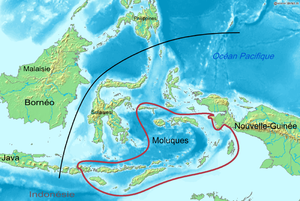Central Malayo-Polynesian languages
| Central Malayo-Polynesian (perhaps a linkage, not a family) | |
|---|---|
| Geographic distribution: | Indonesia |
| Linguistic classification: | Austronesian Paiwanic Malayo-Polynesian (MP) Nuclear MP Central-Eastern MP ? Central Malayo-Polynesian |
| Subdivisions: | Several branches |
| ISO 639-5: | plf |
| The Central MP languages (red). (In black is the Wallace Line.) | |
The Central Malayo-Polynesian (CMP) linkage is an erstwhile branch of Austronesian languages. The languages are spoken in the Lesser Sunda and Maluku Islands of the Banda Sea, in an area corresponding closely to the Indonesian provinces of East Nusa Tenggara and Maluku and the nation of East Timor (excepting the Papuan languages of Timor and nearby islands), but with the Bima language extending to the eastern half of Sumbawa Island in the province of West Nusa Tenggara and the Sula languages of the in the southwest corner of the province of North Maluku. The principal islands in this region are Sumbawa, Sumba, Flores, Timor, Buru, and Seram. The numerically most important languages are Bima, of western Flores, Uab Meto of West Timor, and Tetum, the national language of East Timor.
The Central Malayo-Polynesian languages are for the most part poorly attested, and they do not constitute a coherent group. Analysis of the Austronesian Basic Vocabulary Database (2008) did not discern the possibility of an exclusive relationship. Many of the proposed defining features of CMP are not found in the geographic extremes of the area. Therefore some linguists consider it a linkage; a conservative classification might consider CMP to be a convenient term for the Central-Eastern Malayo-Polynesian languages which are not Eastern Malayo-Polynesian languages, themselves both poorly supported groups. (Grimes 1991) Languages in the east of Flores and nearby islands, such as Savu, have especially large amounts of apparently non-Austronesian basic vocabulary (Würm 1975), but all of the CMP languages appear to have a non-Austronesian substrate that sets them apart.
See Central-Eastern Malayo-Polynesian languages for the interrelationships of the Central MP languages.
References
Retrieved from : http://en.wikipedia.org/wiki/Central_Malayo-Polynesian_languages
